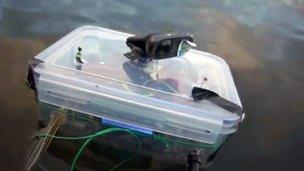Reservoir bugs - Dundee students develop 'cure' using E.coli
- Published
Toxic algal blooms can develop in Dundee's Clatto reservoir sometimes develop during the summer
Clatto reservoir is one of the jewels of Camperdown Country Park on the northern outskirts of Dundee.
Once it provided the city with drinking water.
And while that role is long past it's still an excellent venue for sailing, canoeing or just walking the dog.
But if the weather gets too warm for too long it's off limits to the public.
"This is a contained water body," says senior countryside ranger George Potts, "and it heats up quite well.
"And as it heats up algal blooms can occur.
"Some of these algal blooms are harmless but other ones - the blue-green algae in particular - can produce toxins which are harmful."
Foremost among these toxins is microcystin. It's harmful to plants and animals and wreaks havoc on human livers.
Binds proteins
Several attempts have been made over the years to rid Clatto of the problem but none has proved a permanent fix. But a team of undergraduates from Dundee University have come up with a bright idea.
They were looking for a project to enter in a competition called iGEM, which is run by the International Genetically Engineered Machine Foundation.
The foundation was spun out of the Massachusetts Institute of Technology (MIT) last year. Its stated aims are education, competition and the advancement of synthetic biology.
For the Dundee team, Clatto's toxin problem fitted the bill.
"It was something to do in the summer," says Ewa Grabowiezka.
"We're all undergraduate students and we thought we had to do something with our lives rather than just partying all the time.

The students say the strain of E.coli being used in the research is harmless
"So we thought we'd do something useful."
That something is Toximop, a system which aims to mop up the toxins produced by algal blooms before they reach our livers.
Microcystin does its damage by binding strongly to proteins in our bodies. The Dundee team worked to genetically engineer E.coli bacteria to bind to the microcystin while it was still in the water.
Another of the undergraduates, Kyle Buchan, explains: "What we've basically done is make E.coli make this protein.
"And therefore when we put it into water with this toxin it just binds this toxin in the same way.
"And then you can just take the cells out."
Bird droppings
Algal blooms occur when warm water combines with an abundance of nutrients. In the case of Clatto these nutrients are high in phosphates.
Fertiliser runoff from agriculture was one suspect, but the reservoir has now been isolated from such sources and suspicion has alighted on another candidate.
To put no finer a point on it, bird poop.
As Clatto is home to many species of waterfowl, asking them to move elsewhere is not an option. Hence Toximop.
Not that the algal bloom problem is confined to Clatto. As another member of the team, John Allan, says, it's a global issue.
He says a good example is Lake Erie in the US.
"This is a massive thing for their tourist industry, which is an $11.5bn industry," he says.
"In 2001 they had their worst algal bloom on record with the same sort of bugs we've got living in this loch here."

The students have also designed a floating robot called Moptopus to build up a profile of algae in the water
One of the principles of the iGem competition is to get young scientists working across scientific disciplines. Genetic engineering and microbiology aren't enough: the Dundee team also includes specialisms like physics, mathematics and applied computing.
Which is why Kyle Harrison found himself working on a floating robot called Moptopus.
"It uses an array of sensors that collect data from the lake," Kyle says.
"And this builds up a profile or model of what's going on in the lake.
"Then we can predict how algal blooms form and their inferred toxicity."
Two aspects of Toximop might raise a few eyebrows: genetic engineering and E.coli.
Chris Earl says most strains of E.coli are harmless - it's one of these they're using for the project.
And he points out that public engagement is a necessary part of what they're doing.
"The public have scepticism towards these terms," he says. "But we've engaged the public throughout our project.
"And we've tailored our project to the needs of the public."
Gold medal
The team aren't claiming to have solved Clatto's toxic problem. While they've proved that a genetically engineered E.coli "mop" can bind to the microcystin, the process isn't yet efficient enough to be deployed in the reservoir.
Nevertheless the idea has passed the proof of concept stage and the project has won a gold medal in iGEM's European final.
This weekend the Dundee students will be at MIT to pitch their ideas in iGEM's collegiate world championship final. They'll be up against projects which have similarly made it to MIT from across the globe.
Back on this side of the Atlantic, Clatto remains a lovely place to learn about, or simply enjoy, nature. There'll be no need to worry about its blooming problem until the weather gets a lot warmer again.
- Published31 October 2013